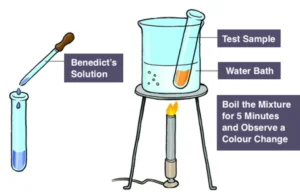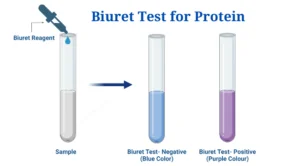Introduction
Carbohydrates, proteins, lipids, and nucleic acids are fundamental organic molecules present in living organisms. These biological macromolecules contain carbon and may also include hydrogen, oxygen, nitrogen, phosphorus, sulfur, and other minor elements. Carbohydrates, composed of monosaccharide units, function primarily in energy storage (Mika et al., 2024). The presence of macromolecules is determined using various methods. For example, the presence of reducing sugars is detected using Benedict’s reagent, which changes color from green to reddish upon oxidation of cupric ions (Benedict, 2002). Starch, a polysaccharide with long chains of glucose units, is identified through the iodine test, which turns blue-black in the presence of starch due to iodine’s interaction with the helical structure of the polymer. Proteins, consisting of long chains of amino acids, perform critical roles such as enzymatic activity, molecular transport, and structural support (Pesek et al., 2022). The Biuret test detects proteins by forming a violet complex with copper ions that bind to peptide bonds (Lubran, 1978). Lipids, which include fats, oils, and phospholipids, are primarily involved in energy storage and membrane structure. The presence of lipids is confirmed using the grease spot test, where lipids leave a translucent mark on paper (Grease Spot Test, n.d.).
In this experiment, Benedict’s test, iodine test, Biuret test, and grease spot test were performed to qualitatively determine the presence of carbohydrates, starch, proteins, and lipids in various solutions, respectively (Mika et al., 2024). The hypothesis of this experiment is that, if carbohydrates, starch, proteins, and lipids are present in the tested solutions, then the Benedict’s test will produce a color change indicating the presence of reducing sugars, the iodine test will result in a blue-black coloration confirming starch, the Biuret test will yield a violet color showing the presence of proteins, and the grease spot test will reveal a translucent mark indicating the presence of lipids.
Materials and Methods
To detect carbohydrates, Benedict’s test was performed (Mika et al., 2024). Eight test tubes were prepared, each containing 10 drops of a different solution: onion juice, potato juice, sucrose solution, glucose solution, distilled water, fructose solution, starch solution, and chyme. To each test tube, 1 ml of Benedict’s reagent was added, and the initial color was recorded. The test tubes were then placed in a boiling water bath for 3 minutes. After cooling, the final color of each solution was noted and analyzed to determine the presence of carbohydrates.

For starch detection, the iodine test was conducted following a similar procedure to Benedict’s test. Instead of Benedict’s reagent, 4-6 drops of iodine solution were added to each test tube containing the same set of solutions (Mika et al., 2024). Boiling was not performed in this test.
Protein presence was assessed using the Biuret test. Six test tubes were prepared with 2 ml of each of the following solutions: egg albumin, honey, amino acids, distilled water, protein solution, and chyme. The initial color of each solution was recorded. To each test tube, 1 ml of 2.5% NaOH solution was added, followed by 8-10 drops of Biuret reagent. The solutions were gently mixed, and any color changes were observed to determine the presence of proteins (Mika et al., 2024).

Lipids were detected using the grease spot test. Six small squares were cut from a brown paper bag and labeled accordingly. One drop of each of the following substances was placed on separate squares: maple syrup, chocolate syrup, canola oil, peanut butter, icing, and chyme. The squares were allowed to dry, and the presence of a translucent grease spot was observed to confirm the presence of lipids (Mika et al., 2024).
Results
In Benedict’s test, only onion juice changed color from blue to green, indicating the presence of reducing sugars. All other samples remained blue, showing no reducing sugars were present.
Table 1: Benedict’s Test Results
| Tube | Solution (10 drops) | Initial Color | Color After Boiling |
| 1 | Onion juice | White | Green |
| 2 | Potato juice | Brown | Blue |
| 3 | Sucrose solution | Clear | Blue |
| 4 | Glucose solution | Clear | Blue |
| 5 | Distilled water | Clear | Blue |
| 6 | Fructose solution | Clear | Blue |
| 7 | Starch solution | Clear | Blue |
| 8 | Chyme | Milky yellow | Blue |
In the iodine test, all solutions turned brown after the addition of iodine, signifying the absence of starch in all samples.
Table 2: Iodine Test Results
| Tube | Solution (10 drops) | Initial Color | Color After Iodine |
| 1 | Onion juice | White | Brown |
| 2 | Potato juice | Brown | Brown |
| 3 | Sucrose solution | Clear | Brown |
| 4 | Glucose solution | Clear | Brown |
| 5 | Distilled water | Clear | Brown |
| 6 | Fructose solution | Clear | Brown |
| 7 | Starch solution | Clear | Brown |
| 8 | Chyme | Milky yellow | Brown |
The Biuret test showed the presence of proteins in egg albumin, protein solution, and chyme, as evidenced by the purple color change. All other samples remained blue, indicating no protein presence
Table 3: Biuret Test Results
| Tube | Solution (2 ml) | Initial Color | Color After Biuret |
| 1 | Egg albumin solution | Clear | Purple |
| 2 | Honey solution | Yellow | Blue |
| 3 | Amino acid solution | Yellow | Blue |
| 4 | Distilled water | Clear | Blue |
| 5 | Protein solution | Clear | Purple |
| 6 | Chyme | Yellowish | Purple |
In the grease spot test, lipids were detected in canola oil, peanut butter, and icing, as indicated by the formation of large, visible oily spots. No oily spots were observed in the other samples.
Table 4: Grease Spot Test Results
| Tube | Solution (1 drop) | Description of Grease Spot Reaction |
| 1 | Maple syrup | Spots didn’t move, no grease |
| 2 | Chocolate syrup | Spots didn’t move, no grease |
| 3 | Canola oil | Spot became larger, and oily |
| 4 | Peanut butter | Spot became larger, and oily |
| 5 | Icing | Spot became larger, and oily |
| 6 | Chyme | Spot didn’t move, liquid, no grease |
Discussion
The results support the hypothesis that the presence of carbohydrates, starch, proteins, and lipids causes specific color changes—green, orange, brick red, purple, and the appearance of a greasy spot—when their respective reagents are added. Qualitative analysis of the samples evaluating the color change helps to determine the specific macromolecule in the solution.
Benedict’s test indicated the presence of reducing sugars in onion juice, which changed color to green (Table 1). This color change confirms that reducing sugars are present, as they can reduce cupric ions to cuprous oxide. Conversely, the other samples did not change color, indicating the absence of reducing sugars (Benedict, 2002).
The iodine test revealed no presence of starch in any of the samples, including the starch solution itself (Table 2). Typically, iodine forms a blue-black complex with starch, but the lack of color change in our tests suggests that either the starch was degraded, or the iodine solution was ineffective (Pesek et al., 2022). Starch solutions have a limited shelf life and may degrade over time, which could explain the negative results. Additionally, issues with the iodine solution could have contributed to the lack of reaction.
The Biuret test showed the presence of proteins in egg albumin, protein solution, and chyme, as evidenced by the purple color change (Table 3). The absence of color change in the amino acid solution can be explained by the lack of peptide bonds; the Biuret reagent specifically reacts with peptide bonds, and single amino acids do not contain these bonds, resulting in no color change (Lubran, 1978).
In the grease spot test, lipids were detected in canola oil, peanut butter, and icing, which produced visible oily spots (Table 4). The absence of greasy spots in maple syrup, chocolate syrup, and chyme confirmed the lack of lipids in these samples. The grease spot test is effective for detecting lipids due to their ability to create an oily residue on paper (Grease Spot Test, n.d.).
For improved experimental reliability, it is important to use freshly prepared solutions and incorporate both positive and negative controls in each test. For example, the iodine test for starch lacked a positive control, making it difficult to interpret the results accurately. Including a known positive sample would have clarified whether the issue was with the starch solution or the iodine reagent.
Further experiments
To enhance the analysis of carbohydrates, starch, proteins, and lipids, quantitative methods such as colorimetric assays and Soxhlet extraction could be used to measure concentrations more accurately. Additionally, incorporating specific enzyme activity assays and advanced techniques like thin-layer chromatography would offer understanding into the biochemical properties and types of these macromolecules.
References
- Benedict S. R. (2002). A reagent for the detection of reducing sugars. 1908. The Journal of biological chemistry, 277(16), e5.
- Lubran M. M. (1978). The measurement of total serum proteins by the Biuret method. Annals of clinical and laboratory science, 8(2), 106–110.
- Grease Spot Test. (n.d.). Lipids Identification Methods. Retrieved from [https://cdn.agclassroom.org/media/uploads/LP841/Grease_spot_test_student_instruction s.pdf]
- Pesek, S., Lehene, M., Brânzanic, A. M. V., & Silaghi-Dumitrescu, R. (2022). On the Origin of the Blue Color in The Iodine/Iodide/Starch Supramolecular Complex. Molecules (Basel, Switzerland), 27(24), 8974.
https://doi.org/10.3390/molecules27248974
- Mika, T. A., Klein, R. J., Bullerjahn, A. E., Connour, R. L., Swimmer, L. M., White, R.
E., Gosses, M. W., Carter, T. E., Andrews, A. M., Maier, J. L., & Sidiq, F. (Eds.). (2024). Anatomy and physiology BIO 211 laboratory manual (3rd ed.). Owens Community College.